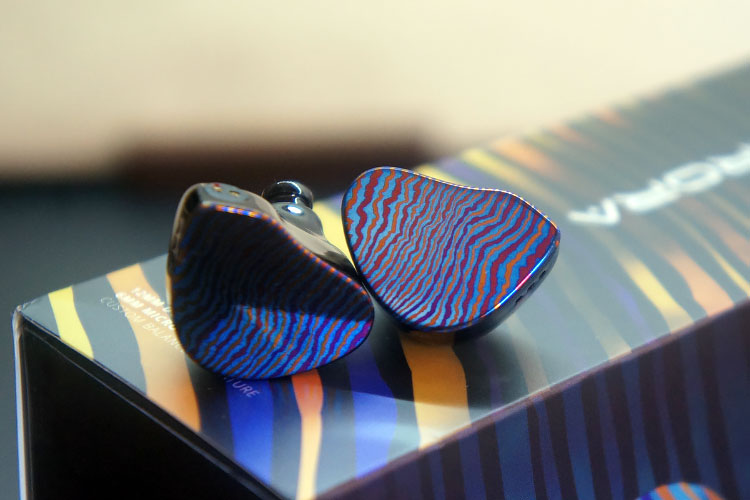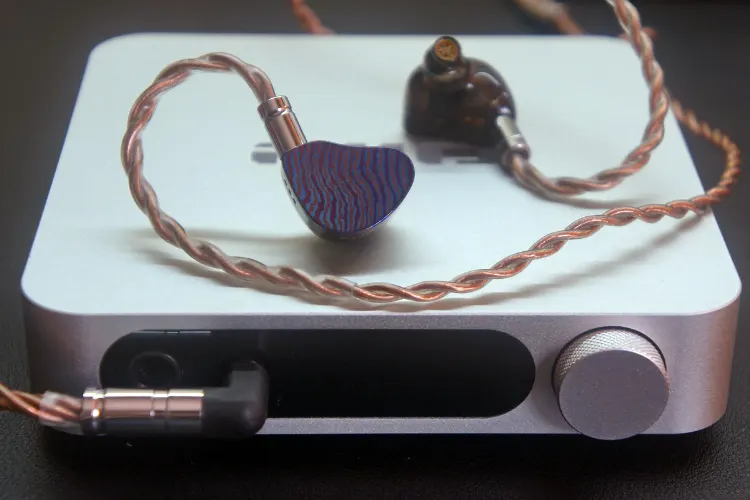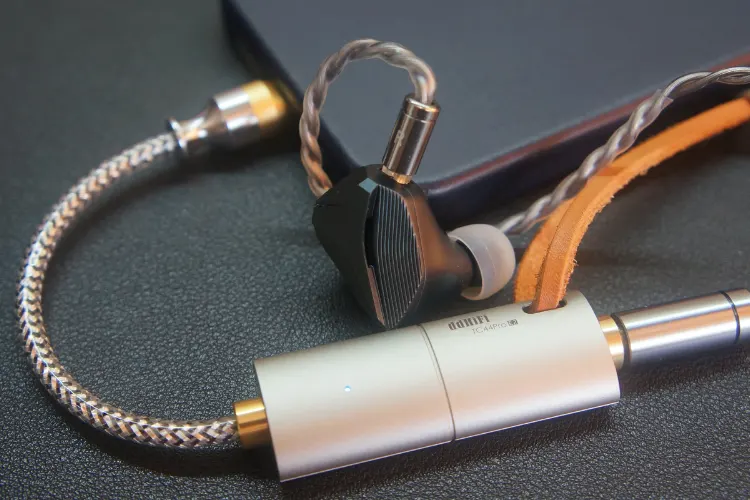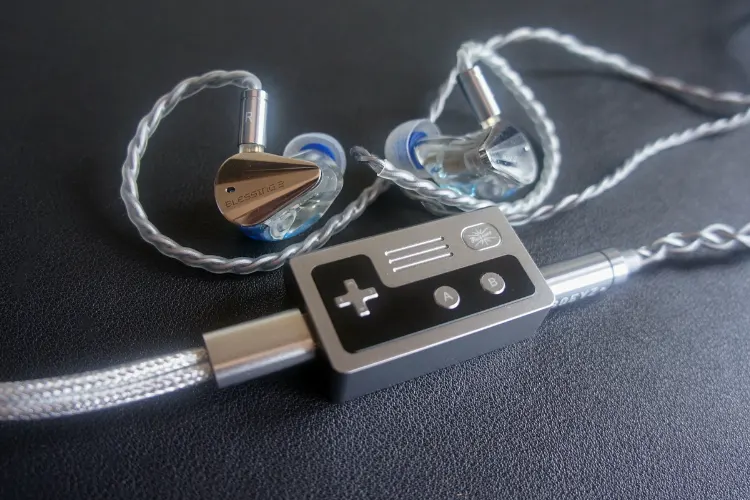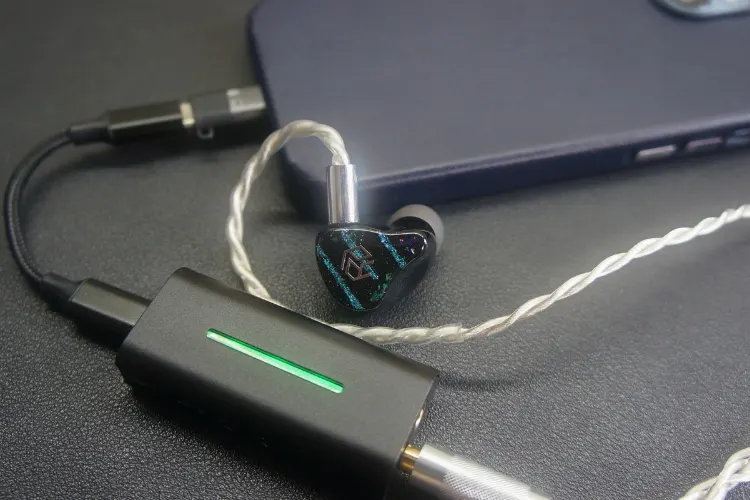Synergy
Efficiency
The Aurora has an impedance of 30Ω and a sensitivity of 105 dB/V, making it compatible with laptops, tablets, DAPs, and smartphones. However, its treble response and resolution performance significantly benefit from a more powerful amplifier or dongle DAC.
During my on-the-go testing with the Aurora and its stock modular 3.5mm/4.4mm cable, I paired it with the ddHifi TC35Pro M2, ddHiFi TC44Pro E2, and Kiwi Ears Allegro dongle DACs. For desktop options, I connected the Aurora to the FiiO K11, testing its SE and balanced outputs.
While I achieved full extension and resolution in the sub-bass and treble regions with the dongle DACs, the higher-end treble occasionally sounded shrill through the 3.5 SE dongles.
On the K11’s balanced output, I could drive the Aurora to a comfortable listening level at around 39% max volume on the high-gain setting. Compared to its 4.4mm balanced output, the 3.5 SE output of the K11 made the Aurora sound shrill.
Pairings
The Aurora pairs best with more powerful, DAPS, dongles, and sources with BAL output. Throughout my testing, I preferred pairing the Aurora with the Fiio K11’s balanced output and the ddHiFi TC44 Pro E2.
With more powerful balanced sources, the Aurora had a more natural treble timbre that minimized shrillness on the higher end of the treble.
The neutral tonality of the K11 and the ddHiFi TC44Pro E2 maintained the enjoyable sound signature of the Aurora. When connected to the 4.4mm balanced output of the Kiwi Ears Allegro, the dongle’s metallic timber in the lower treble region disrupted the natural tonality of the Aurora.
Select Comparisons
Hidizs MP145 Gold Titanium
Technical
The Hidizs MP145 Golden Titanium has a simpler driver configuration, opting for a single full-range 14.5mm planar magnetic driver. The Aurora uses a more complex tribrid design with a single 12mm dynamic driver, 2 BA, and a 6mm micro-planar driver.
The MP145 has an impedance and sensitivity of 30Ω and 104db, while the Aurora has the same impedance of 30Ω and a slightly higher sensitivity of 105db. In practice, the MP145 was the slightly easier of the two to drive.
Design
The Aurora’s main body is constructed from 3D-printed resin, however, the shell is quite large compared to competing IEMs. The separate faceplate is constructed out of 3D printing as well, however, the titanium filament gives it a unique Damascus-inspired finish.
The commemorative MP145 is constructed almost entirely out of titanium with a gold finish and is significantly denser than the Aurora. It also has a unique whale-inspired geometric pattern for its faceplate.
In day-to-day usage, I found the Aurora more comfortable. Despite its shell feeling larger than the MP145’s, the Hidizs’ denser shell created some weight-related discomfort.
Performance
The Aurora has a punchier and tighter sub-bass compared to the MP145, offering a more impactful and controlled low-end experience.
It has a more textured and tactile bass profile that makes each strike more satisfying with better note weight. Complex bass lines in funk and disco tracks are articulated with a better sense of resolution and note weight through the aurora.
The vocals on the MP145 sound dull and lifeless in comparison, providing sufficient detail for string instruments, but not the same quality.
Guitar strums on the Aurora exhibit very satisfying resolution and note weight, making them stand out against the MP145. Vocals have more nuance, including noticeable echoes, whereas the MP145 can make vocals sound less natural and more metallic.
Hi-hats are more emphasized with the MP145, particularly in stripped-down pop or alternative tracks. The pronounced highs of the MP145 make electric guitars sound more shrill and energetic.
Although the MP145 has more treble energy, the Aurora still offers better resolution. Hi-hats always take center stage with the MP145, making the highs more evident in the mix. However, the Aurora surpasses the MP145 in treble resolution and overall clarity.
Moondrop Blessing 3
Technical
The Moondrop Blessing 3 is a hybrid set of IEMs, with a dual 10mm dynamic driver and 4 BA driver implementation. The Aurora opts for a tribrid design with a single 12mm dynamic driver, 2 BA drivers, and an additional 6mm micro planar driver.
The Aurora has an impedance and sensitivity of 30Ω and 105 db/Vrms, with the Blessing 3 a bit lower for impedance at 14.8Ω with a sensitivity rating of 100 dB/mW. I found that Blessing 3 was the harder of the two IEMs to drive from my dongle line-up.
Design
Both IEMs are constructed out of 3D Printed shells, with the Blessing 3 opting for a more transparent finish compared to the darker brown tint on Aurora’s shell.
Since both IEMs are composed of multiple drivers with complex drivers, their shells are both on the larger side.
Both IEMs have a contrasting faceplate, with the Aurora opting for a 3D printed version constructed out of titanium filament, giving it a Damascus aesthetic. The Blessing 3 instead opts for a polished metal faceplate, giving it an almost mirror-like finish that is more prone to fingerprints and micro scratches.
I found both IEMs similar in weight and size, making them equally comfortable to wear.
Performance
The Aurora has a more exciting sound signature when compared to the Blessing 3. The Blessing 3 excels in soundstage and imaging, providing a more spacious and accurate placement of instruments and vocals.
Despite a stronger mid-emphasis, the Blessing 3 lacks the detail of Aurora’s mids, making the latter more engaging in that frequency range.
The overall presentation of the Blessing 3 is more relaxing, making it ideal for laid-back listening sessions, whereas the Aurora’s energetic sound is better suited for active listening.
The Aurora delivers a significantly stronger sub-bass performance. Its sub-bass is tighter and punchier, providing a more visceral and impactful listening experience.
In the mid-bass region, both IEMs are quite similar in tonality and focus, handling bass guitars and higher frequency toms and percussions with comparable proficiency. The Aurora stands out with its more tactile and textured sub-bass performance, adding a layer of excitement to bass-heavy tracks.
The Blessing 3 leans towards a warmer sound, offering a more bodied presentation with vocals and better note weight. The Aurora excels in vocal detail, making voices sound clearer and more impressive.
The soundscape of the Blessing 3 is larger, but the Aurora provides a more detailed soundscape with better dynamics. The vocal echoes on the Aurora are easier to identify, and its mids are richer in detail.
The Aurora emphasizes the highs more prominently, bringing snare drums and hi-hats to the forefront. Its highs are more detailed and forward, with hi-hats being significantly more resolving. This adds a vibrant and lively quality to the overall sound.
Yanyin Canon II
Technical
The Yanyin Canon II is a hybrid driver IEM, with a single dynamic driver and 4 balanced armature driver implementation. The more complex tribrid configuration of the Aurora is composed of a single dynamic driver as well, but instead uses 2 balanced armature drivers and a single micro-planar driver.
The Canon II has a 27Ω impedance and a sensitivity rating of 112 dB @1Khz, whilst the Aurora has an impedance and sensitivity of 30Ω and 105 dB/Vrms. In line with this, I found that the Canon II was the easiest of the two IEMs to drive.
Design
Both monitors have a 3D-printed resin shell, with the Canon II opting for black resin and a unibody design wherein the faceplate and the shell are all one piece. The faceplate is also made of resin with an attractively designed galaxy pattern.
The Aurora opts for a separate 3D-printed faceplate constructed out of titanium filament and that striking Damascus design.
In my testing, I found that the Canon II was significantly more comfortable because of its lighter size and smaller shell. The Aurora is by no means uncomfortable, but for extended listening sessions, I found the Canon II’s less obstructive in-ear.
Performance
While IEMs have similar levels of sub-bass, the Canon II emphasizes mid-bass more. The Canon II’s bass tends to bleed more into other frequencies whereas the Aurora offers tighter and cleaner bass, making it sound fun while maintaining clarity and musicality in the mids.
The string resolution and fidelity are significantly superior on the Aurora. Keys have much higher fidelity and its mids are more forward and detailed. Vocals are clearer and more pronounced. The superior fidelity of the midrange sets it apart, making it feel like it’s in a class of its own.
This forwardness in the mids and vocals on the Aurora gives female and higher-pitched male vocal performances a better sense of emotion and musicality. The Canon II’s warmer tonality provides male vocals more authority and weight.
The hi-hats on the Canon 2 II are shimmery, allowing the paradiddle of hi-hats and snares to sound prominent. The treble on the Aurora is clearer, with more air and sparkle.
While the Canon II offers a more controlled and relaxing treble, it can come off as veiled when compared to the more resolving treble of the Aurora.
High-frequency synths and cymbal crashes are more resolving and audible on the Aurora. Additionally, it has a wider soundstage with better instrument positioning, enhancing its overall treble performance compared to the Canon II.
My Verdict
The 7Hz Aurora is a competitive new tribrid contender in the $400 segment. The 6mm micro planar driver for the treble region delivers good detail and resolution, with strong and impactful sub-bass tonality from its 12mm dynamic driver.
Its unique titanium Damascus faceplate is visually striking, and its inclusion of a high-quality modular 3.5mm/4.4mm cable is a very good inclusion for the price.
Compared to other IEMs in the price range, some listeners may find the aurora aggressive and lacking in male vocal weight.
However, with its exciting bass and treble profile, the 7Hz Aurora is a good fit for audiophiles who actively listen to their music to pick out every aspect of the mix and performances.
7Hz Aurora Technical Specifications
- Driver configuration: 1 DD+ 2 BA + 1 Micro-Planar
- Frequency response: 5 Hz – 40 kHz
- Impedance: 30 Ω
- Sensitivity: 105 dB/V @ 1 kHz
- Connector: 0.78mm 2-pin
- Plug: 3.5mm and 4.4mm modular jacks

